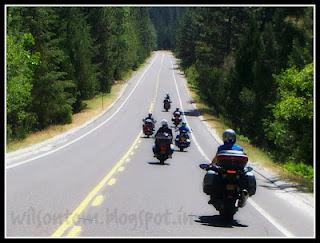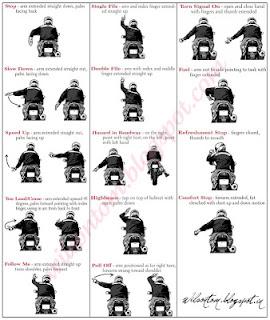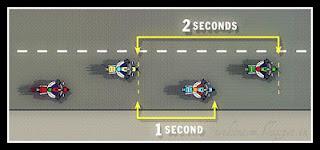 Motorbikes and freedom is really close to each other. No other vehicle allows a traveler to experience the speed, grace, and sheer excitement that a motorcycle does. However, there are still a few “rules” that bikers expect each other to follow, in addition to regular traffic safety laws. New (or rusty) motorcyclists should be sure to take a class on motorcycle safety to brush up on important rules in addition to these; this isn’t a comprehensive list.
Motorbikes and freedom is really close to each other. No other vehicle allows a traveler to experience the speed, grace, and sheer excitement that a motorcycle does. However, there are still a few “rules” that bikers expect each other to follow, in addition to regular traffic safety laws. New (or rusty) motorcyclists should be sure to take a class on motorcycle safety to brush up on important rules in addition to these; this isn’t a comprehensive list.Riding in a group or even alone means that certain uncertain or exiting thing come to face. For instance:
• Each rider is ultimately responsible for his or her own safety, regardless of what other riders may do. So be aware of other riders’ actions too.
• Don’t show off.
• Maintain a regular pace—don’t slow down immediately or zoom up suddenly. Spread out when traveling around corners or on curvy roads.
• In a group, prearrange the stopping points, and discuss other relevant information before the ride begins.
• The lead biker in a group ride should be sure that the other riders are ready to go and that there is enough room in traffic for the whole group to get on the road. It’s a good idea for the lead biker to have traveled the route ahead of time to reduce navigational mistakes and communication errors.
• Riders should leave each other with enough following distance and reaction time, and be alert to speed changes and signals by riders who are farther ahead, not just riders who are immediately in front of them.
• A staggered formation is most common except in certain situations—this means that each rider stays on a different side of the lane than the riders immediately before and after him (or her). More experienced riders should use the right positions.
• On a curvy road, it is typical to switch to a single-file formation.
• The most experienced rider is the “drag bike” (or tail gunner). This rider helps in managing traffic situations, such as changing lanes as a group, and also assists riders who need help for any reason.
• Pointing down with your arm at a 45-degree angle (left or right depending on the situation) indicates a road hazard to the other riders in the group.
• To signal stop, hold your left arm down at a 45 degree angle with the palm facing the rider behind you.
• Pointing to the tank means that a stop is urgent, either for fuel or for other reasons.
• The signal for “slow down” is to hold the left arm out straight and move it up and down.
• A “thumbs up” signal means “Ready to ride!”
• Whether riding in a group or not, many riders consider it courteous to wave briefly at other riders. However, if your hands are otherwise occupied it is just as acceptable to nod.
• If you are concentrating on hazardous road conditions, it is fine to refrain from acknowledging another rider.
Always safety must be the prime priority, and etiquette is actually very much a part of safety. Not only is it pleasant and social to understand biker amenities, the predictability of understanding and following the rules makes the ride safer for experienced and inexperienced riders alike.
Staying Safe
 Safety is the number one concern while riding in a group and it’s complicated by the sheer number of riders you’ll be cooperating with during the day.
Safety is the number one concern while riding in a group and it’s complicated by the sheer number of riders you’ll be cooperating with during the day.There are some simple things you can take into consideration if you have planned or planning to take part in a large group ride. At least one rider should carry a First Aid Kit, and everyone should know who has it. Feel free to make sure all your fellow riders know if you happen to have emergency training. Anyone along on the ride have serious physical limitations like poor vision or bad tires? It’s good to keep an eye on your fellow riders in this regard, both for their sake and yours.
Make sure that whoever leads the pack follows all traffic and speed laws at all times. Nothing worse than having the constabulary ruin an excellent day by stopping the whole group and picking over the bikes and riders with a fine tooth comb for violations. Keep in mind that it’s much better to get momentarily separated from the group than to end up in a pile of twisted motorcycle at the side of the road or in the back seat of a police car.
Know what you’re getting involved with
Before the trip the whole group should get to know each other well. As a part of knowing each other a short meeting in the parking lot with the group to let everyone know the precise route is a mandatory event. No one wants to be uncomfortable, either with the route or the duration of a ride, so make sure you have as much information as possible about both before you take off.
Simple maps are always a good idea, even in this day and age of GPS devices and cell phones. Planning out stops is also a good idea to make sure you don’t find yourself out of synch with the group when your bike lacks the range to go 350 Kms between fuel stops. How much fun is it to be separated from the group with no idea how to link back up with the ride? That would be no fun at all.
Expect the leaders of the group to have the good sense to stop every 100 or 150 Kms if the group includes less experienced riders and no more than 200 miles for groups composed of experienced riders. While there are no real hard and fast rules here, weather conditions, heat (or lack of it) and traffic density should all guide any decisions the leaders make on how long to ride at a pop. Riding in heavy traffic is much more mentally and physically taxing that a slow cruise along country roads with little traffic.
Don’t like to ride at night? Make sure you know how long the group plans to be out before heading to rest and finding yourself on your machine for two hours in pitch black conditions.
Who’s running the Show
The leader or organizer has complete responsibility for the riders following in their wake, and not taking that position seriously is a disservice to fellow riders and dangerous in the bargain. The leader is tasked with monitoring the group for problems and communicating unsafe conditions to everyone on the ride. The role doesn’t mean you have to be the best or fastest rider. Taking your fellow riders outside their comfort zone is irresponsible, and should you find yourself on a ride where that’s the case, get out of the group ASAP. Unless you signed up for one, a day spent racing and trying to peel the “chicken strips” off your tires could prove disastrous to you and others in the group.
Expect the leader to ride at the left front position to give them the optimum view of the road ahead. They’ll set the pace, so follow as long as you feel comfortable with their style and abilities. It’s just bad form – and sometimes even dangerous – for riders to pass the leader, so just don’t do it.
You should also find that an experienced rider is tasked as a “sweeper” to bring up the rear and monitor the end of the cadre. This rider is generally positioned in the left rear lane to give them the best possible view of the entire group and the action ahead of them on the route. Don’t fall behind the sweep and make sure to signal them should you have mechanical difficulty, physical problems or plan to leave the ride.
Your position in the group
You’re going to be riding in a “staggered” or “diamond” formation to provide the highest possible safety conditions and increase the length of each rider’s reaction time. This kind of formation is the rule of the road, and you’ll be using one third of the road on either the right or left side of the road depending on your place. You may end up riding in a side by side column of twos for short distances in traffic or at stops, but be prepared to re-form the staggered configuration the second the road conditions allow it.
 Know all the hand signals and use them. Keep them simple and easily understood. The left arm straight out with the palm up generally means it’s time to speed up. The standard DMV hand signals for turns should be used.
Know all the hand signals and use them. Keep them simple and easily understood. The left arm straight out with the palm up generally means it’s time to speed up. The standard DMV hand signals for turns should be used.Consider providing a chase vehicle and be aware if one is part of the group. It’s always nice if a non-rider is along to carry a can of gas, supplies to fix flats, maybe a couple of cans of motor oil, a set of plugs and a few common tools in US and metric sizes.

